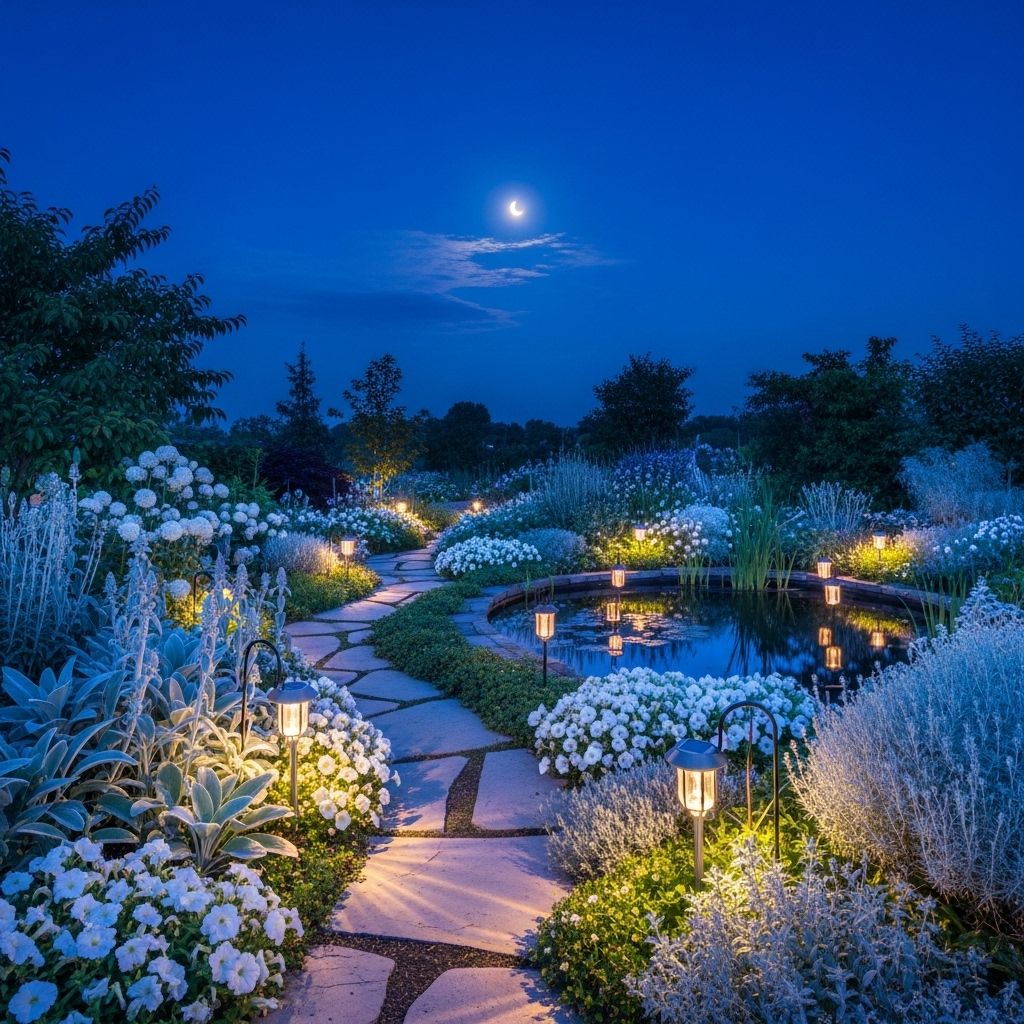Moon Garden: A Complete Guide To Designing A Nighttime Oasis
Discover the magic of moonlit gardens with plants that shine after dark and create a serene nighttime retreat in your own backyard

Image: HearthJunction Design Team
What Is a Moon Garden?
A moon garden is a specially designed outdoor space meant to be enjoyed from dusk to dark—illuminated by the gentle glow of moonlight. These enchanting gardens feature carefully selected plants and elements that reflect moonlight, creating a magical atmosphere when the sun goes down. The soft luminescence of white flowers, silvery foliage, and light-colored accessories capture and reflect even the slightest bit of moonlight, turning an ordinary garden into a nighttime oasis.
Moon gardens have a rich history dating back centuries, when evening gardens provided a cool retreat from summer heat. Today, these gardens offer a peaceful sanctuary for evening relaxation and meditation. For busy people who can’t enjoy their gardens during daylight hours, a moon garden extends the pleasure of gardening well into the evening, providing a tranquil space to unwind after a long day.
Choosing the Perfect Location
Selecting the right spot for your moon garden is crucial for maximizing its nighttime beauty. Consider these factors when choosing your location:
Moon Exposure
Position your garden where it will receive ample moonlight. South or west-facing locations often provide the best exposure to evening and nighttime moon glow. Take time to observe how moonlight moves through your yard throughout the lunar cycle to identify optimal spots.
Visibility from Indoors
Place your moon garden where you can easily view it from inside your home, especially from areas you frequent in the evening. A garden visible from a bedroom window, living room, or dining area allows you to enjoy the moonlit view even when you’re indoors.
Minimize Light Pollution
Choose a location away from bright street lights, security lights, or neighbor’s floodlights that could diminish the subtle effects of moonlight on your garden. If light pollution is unavoidable, consider using strategic plantings or structures to block unwanted artificial light.
Essential Moon Garden Plants
The plants you choose form the foundation of your moon garden. Focus on varieties that have one or more of these qualities: white flowers, silvery or variegated foliage, evening fragrance, or night-blooming habits.
White Flowering Plants
White flowers are the stars of a moon garden, glowing ethereally in the moonlight. Include a variety of heights, textures, and bloom times to create visual interest throughout the growing season.
Perennials
- White Coneflower (Echinacea purpurea ‘White Swan’)
- Shasta Daisy (Leucanthemum x superbum)
- White Bleeding Heart (Dicentra spectabilis ‘Alba’)
- White Garden Phlox (Phlox paniculata ‘David’)
- White Foxglove (Digitalis purpurea ‘Alba’)
Annuals
- White Petunia (Petunia x hybrida)
- Sweet Alyssum (Lobularia maritima)
- White Cosmos (Cosmos bipinnatus ‘Purity’)
- White Impatiens (Impatiens walleriana)
- Moonflower (Ipomoea alba)
Silver and Variegated Foliage
Plants with silver, gray, or variegated foliage reflect moonlight beautifully, adding dimension and interest to your garden even when flowers aren’t blooming.
- Lamb’s Ears (Stachys byzantina)
- Silver Sage (Salvia argentea)
- Dusty Miller (Senecio cineraria)
- Silver Mound Artemisia (Artemisia schmidtiana)
- Variegated Hostas
- Japanese Painted Fern (Athyrium niponicum)
Night-Blooming and Fragrant Plants
Some plants reserve their show for the evening hours, opening their blooms and releasing their heady fragrances as the sun sets. These plants add an extra sensory dimension to your moon garden.
- Evening Primrose (Oenothera speciosa)
- Night-Blooming Jasmine (Cestrum nocturnum)
- Night Phlox (Zaluzianskya capensis)
- Evening Stock (Matthiola longipetala)
- Angel’s Trumpet (Brugmansia)
Design Elements for Moon Gardens
Beyond plants, several key design elements enhance the beauty and functionality of a moon garden, creating a complete nighttime experience.
Pathways
Safe navigation is essential in a nighttime garden. Create clearly defined pathways using light-colored materials that are visible in low light. White gravel or light-colored flagstone paths not only guide your way but also reflect moonlight, adding to the garden’s ethereal quality. Install subtle solar lights along path edges for additional safety on darker nights.
Seating Areas
A comfortable place to sit is crucial for enjoying your moon garden. Position a bench, chair, or small seating area where you can fully immerse yourself in the garden’s evening ambiance. Add a small table for holding a beverage or book. Consider the view from your seating area, ensuring you can see the garden’s highlights while being enveloped in evening fragrance.
Accessories and Focal Points
Strategic accessories enhance a moon garden’s magical quality. Incorporate reflective elements like gazing balls, mirrors, or metallic garden art that capture and multiply moonlight. Light-colored statuary, such as stone figures or lanterns, create focal points that stand out in the darkness. Water features add another dimension, with the sound of moving water enhancing the sensory experience while moonlight dances on the water’s surface.
Subtle Lighting
While the moon provides the primary illumination, subtle supplemental lighting ensures your garden remains magical even on moonless or cloudy nights. Keep artificial lighting soft and low to maintain the garden’s enchanted atmosphere. String lights draped overhead, candles in hurricane lamps, or low-voltage landscape lighting tucked among plants provide gentle illumination without overpowering the moon’s natural glow.
Engaging the Senses
A truly magical moon garden engages all the senses, creating a multidimensional experience that transports visitors to a realm of nighttime wonder.
Sound
Incorporate elements that create gentle, soothing sounds in your moon garden. A small fountain or waterfall provides the relaxing sound of moving water. Plant ornamental grasses that rustle softly in evening breezes. Create habitat for nighttime creatures like crickets and frogs, whose gentle chorus adds to the evening ambiance.
Scent
Fragrance becomes more intense and noticeable in the evening air. Place night-scented plants near seating areas where their perfume can be fully appreciated. Layer plants with different fragrance profiles—sweet, spicy, and earthy—for a complex olfactory experience that changes as you move through the garden.
Touch
Include plants with interesting textures that invite touch. The soft, fuzzy leaves of lamb’s ears, the smooth coolness of hostas, or the delicate feathery quality of ornamental grasses add tactile interest to your garden. Position these plants where visitors can easily reach out and experience their unique textures.
Extending the Celestial Theme
Enhance your moon garden’s magical quality by incorporating elements that celebrate the celestial theme. Plant flowers with star shapes, like clematis or nicotiana. Create crescent-shaped planting beds that echo the phases of the moon. Add decorative elements with star and moon motifs, from wind chimes to garden stakes. For special occasions, hang fairy lights among trees and shrubs to simulate a starry sky.
Seasonal Considerations
A well-designed moon garden offers interest throughout the growing season and even into winter. Plan for succession planting, with different white flowers blooming from spring through fall. Include evergreen shrubs with silvery foliage to maintain structure during winter months. Consider how deciduous plants will cast interesting shadows in winter moonlight, adding another dimension to your garden’s year-round appeal.
Frequently Asked Questions
Q: When is the best time to view a moon garden?
A: Moon gardens are most spectacular during the full moon when illumination is at its peak. However, they can be enjoyed throughout the lunar cycle, with each phase offering a different quality of light and shadow. The hours just after sunset provide the most dramatic effects as your eyes adjust to the darkness and the garden begins to glow.
Q: Can I create a moon garden in a small space?
A: Absolutely! Moon gardens can be adapted to any size space, from expansive landscapes to tiny balconies. Container gardens with white flowers and silver foliage can create a lovely moonlit display in even the smallest area. Focus on a few high-impact plants rather than trying to include everything.
Q: How do I maintain a moon garden?
A: Moon gardens require the same basic care as any garden: proper watering, fertilizing, pruning, and pest management. Deadhead white flowers regularly to promote continuous blooming. Trim back plants that spread too vigorously to maintain your garden’s design. Consider using organic gardening methods to protect the nighttime pollinators that visit your garden.
Q: What if I live in an area with significant light pollution?
A: While moon gardens are most dramatic in areas with minimal light pollution, you can still create an effective nighttime garden in urban or suburban settings. Use structures, screens, or tall plantings to block artificial light sources. Focus on creating a secluded area where the natural cycles of moonlight can be appreciated despite surrounding light pollution.
Q: Can moon gardens attract wildlife?
A: Yes! Moon gardens often attract fascinating nighttime wildlife. Many white, fragrant flowers attract night-pollinating moths and other insects. These, in turn, may attract bats and nocturnal birds. Creating habitat features like small ponds can encourage frogs and other creatures that add their voices to the nighttime garden experience.
References
- https://www.marthastewart.com/how-to-design-moon-garden-7487289
- https://www.gardendesign.com/landscape-design/moon-gardens.html
- https://www.almanac.com/how-design-moon-garden
- https://glovernursery.com/capturing-the-nighttime-beauty-planning-a-moon-garden/
- https://www.shrubhub.com/blog/10-moon-garden-ideas-to-help-you-create-a-whimsical-yard.php
Read full bio of Anjali Sayee












